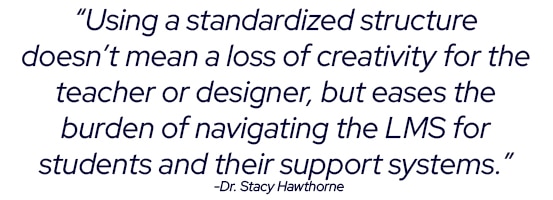When I hear the term standardization, I immediately think of my dad’s work as a lifelong UAW member in Flint, Michigan. As a line worker in an automotive factory, everything he did was standardized. He was never encouraged to offer new or creative ways to improve operations, nor was he given any liberties in how his job was done. He was essentially a cog in the giant machine that is manufacturing. Every day, the same job, the same way. He loved being a UAW member, and as much as this level of structure would have driven me mad, it provided him with a sense of comfort because he always knew exactly what he should be doing and how. There was no ambiguity, just a solid and dependable structure. The truth is that in manufacturing, especially something as potentially dangerous as automobiles, this level of standardization is essential.
As an educator, we often react negatively to the thought of standardization. It’s what got us complex state and national standards for curriculum. Standardization makes most teachers shake when they think of the high-stakes standardized tests that most schools are required to administer. I get it. I didn’t go into teaching to be a cog; I wanted to inspire and challenge students as individuals, not as a collective body. This is the art of teaching that draws us to education in the first place. The contradiction is that if we really want to offer the best experience to our students, we need to agree to certain standards for our course designs, specifically in courses housed in a learning management system (LMS).
Let’s use an analogy. In the traditional school building, we have our classrooms. Students get a schedule, and they know which class to go to at a specific time on a given day. As a math teacher, I taught from my classroom most of the time but not all of the time. If the weather was nice and we were learning concepts such as rate, distance, and time, then we’d go outside to the track and come up with our own problems. Some days we’d go to the media center to use the available resources there to dig deeper into the history of mathematics. No matter where I planned for us to learn, the students knew they needed to go to our classroom. From there, we would venture together to where the actual learning was going to take place on a given day. To me, the LMS is the digital manifestation of the physical classroom. It’s the place that students go to start their learning journey. For this reason, it’s important that everything they need is in the LMS and is organized in a way that offers a smooth and consistent learning experience, regardless of the subject.
Let’s think about a student with three teachers who use the LMS to house course content. One of the benefits of using the LMS is that students can access course content outside of the classroom, including from home or other remote locations. However, suppose a student is working from home, and every course that is using the LMS has a different basic navigational structure or uses different terminology for the navigational structure. In that case, it can be overwhelming to find what they need. In addition, it can be off-putting for families that are trying to support their student(s). Most families want to help their children at home, but they can become frustrated and disenfranchised if they can’t figure out the basic navigation. We want parents to see us as partners, so we must include enough standardization in our online course materials so that they can be a resource to their students.
I’m not suggesting that a math course and an English course built in the LMS are identical. Instead, I suggest that teams, grade levels, or even whole schools collaboratively design a basic course structure that all content teachers can use. This isn’t that difficult and goes a long way to ensure that students are spending their time learning content and not learning to navigate different structures in the LMS. A straightforward example would be to include a set list of navigation buttons such as Announcements, Course Info (e.g., syllabus, lab policies); Course Units (a place where course materials are stored in a thematic or weekly structure); an About Your Teacher (includes contact information). All courses in the LMS need this basic information. Using a standardized structure doesn’t mean a loss of creativity for the teacher or designer, but eases the burden of navigating the LMS for students and their support systems.

I have long believed that providing a consistent and set structure in the LMS is helpful for students and families. What I didn’t realize until recently is how much it helps teachers, particularly those new to a school or teaching with the LMS. A few years ago, one of the new teachers I hired actually thanked me for having a standardized, well-organized template for our courses in the LMS. She said that knowing she didn’t have to design the course structure freed her up to focus on engaging content and lessons. For educators new to this idea, collaboratively designing the standard navigation structure can go a long way toward gaining buy-in. Once the design is done, I think you’ll be surprised at how easy having this level of standardization makes our work as teachers and reduces stress and tension for students and their families. We can now focus on great content and not on the tediousness of LMS course design.
Author:
Dr. Stacy Hawthorne
CoSN’s Emerging Technologies Committee Member
Creative Services Manager for Clarity Innovations
Published: June 8, 2022
CoSN is vendor neutral and does not endorse products or services. Any mention of a specific solution is for contextual purposes.


